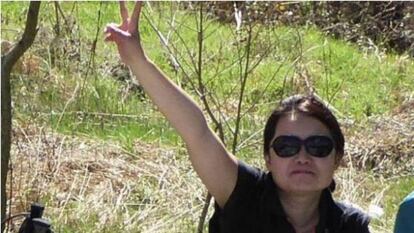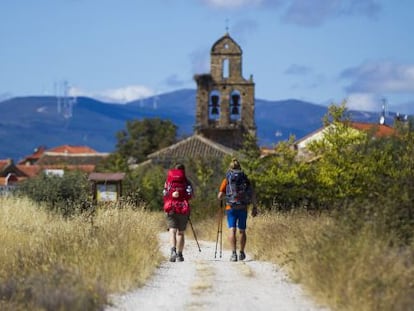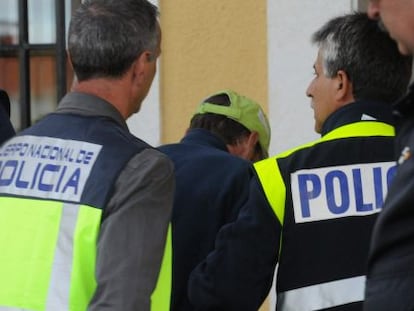US pilgrim murder trial gets underway in Spain
Nine-member jury will decide whether Miguel Ángel Muñoz killed Denise Pikka Thiem in April 2015
A nine-member jury made up of eight women and one man will have to decide whether Miguel Ángel Muñoz killed American tourist Denise Pikka Thiem, who disappeared and was later found murdered after embarking on a solo journey along the popular Spanish pilgrimage route known as the Camino de Santiago, in 2015.

News of the woman’s disappearance made world headlines, and in July of the same year US Republican Senator for Arizona John McCain offered Spain help from the FBI to solve the case – an offer that was turned down. Muñoz was arrested in September, following an intensive hunt involving more than 300 police and military personnel, dogs, horses, army vehicles and a helicopter.
Muñoz initially confessed to the murder, although he later changed his story, despite having taken the authorities to the place where he had hidden her body. The man had been the main suspect from the day that Pikka Thiem disappeared, according to police sources.
US Senator John McCain offered Spain help from the FBI, which was declined
The trial of Muñoz began this week, with the jury due on Tuesday morning to listen to the defendant’s statements at the Provincial Court of León, in northern Spain. However, in the end Muñoz refused to say a thing: “I will not be making a statement, nor will I be answering any questions, neither from the prosecution nor from my lawyer,” he told the court.
The high-profile murder case is expected to see more than 100 witnesses take the stand to provide testimony. The prosecution is calling for a 20-year jail term for murder, plus a further five years for robbery.
Jury deliberations are scheduled to begin on April 4, after jurors have been presented with evidence covering, among other issues, the following questions:
1. Which route did she take? Around noon on April 5, 2015, Denise Pikka Thiem was supposedly walking the Camino de Santiago pilgrimage route by herself, on a journey she had begun in Pamplona, and on this particular day was supposed to cover the stretch of road between Astorga (León) and El Ganso (León).
2. Was she tricked into taking a detour? The victim may have gone to visit Castrillo de los Polvazares (León), and got lost on her way back to the main road because she followed a yellow arrow – used to indicate the official route – that took her down another path leading to the defendant’s property. Did the defendant place or modify this yellow arrow with the deliberate intent of confusing passing pilgrims?

3. Did the defendant accompany her? When the pilgrim passed alongside the property, the defendant may have approached Pikka Thiem and walked part of the way with her.
4. Did Pikka Thiem feel uncomfortable with the defendant’s behavior? This may have prompted the accused to pick up a stick and hit her hard on the head. Once on the ground, he may have struck her at least twice more on her head and once on her chest, potentially causing multiple fractures.
5. Did the defendant drag Denise Pikka Thiem to a secluded spot? Investigators believe she was taken, still alive, to an area out of sight of passers-by, where her backpack was removed and her throat fatally slit.
6. Did the defendant strip Denise Pikka Thiem’s body of its clothes? The attacker is thought to have done this in order to speed up the decomposition of the corpse, which was concealed underground near his property. Her hands were cut off, but have never been located.
7. Did the defendant burn her clothes and belongings? He is thought to have kept at least $1,132 in cash and a hat, later exchanging the dollars for euros at the Astorga branch of Cajamar-Caja Rural.
9. Did the accused dig up the body? In late August 2015, with mounting pressure from the police, the defendant is thought to have dug up the victim’s body, transferring it to the spot where it was eventually found.
10. Did the defendant flee? He was eventually arrested on September 11, 2015 in Grandas de Salime (Asturias).
English version by Susana Urra and Simon Hunter.
Tu suscripción se está usando en otro dispositivo
¿Quieres añadir otro usuario a tu suscripción?
Si continúas leyendo en este dispositivo, no se podrá leer en el otro.
FlechaTu suscripción se está usando en otro dispositivo y solo puedes acceder a EL PAÍS desde un dispositivo a la vez.
Si quieres compartir tu cuenta, cambia tu suscripción a la modalidad Premium, así podrás añadir otro usuario. Cada uno accederá con su propia cuenta de email, lo que os permitirá personalizar vuestra experiencia en EL PAÍS.
¿Tienes una suscripción de empresa? Accede aquí para contratar más cuentas.
En el caso de no saber quién está usando tu cuenta, te recomendamos cambiar tu contraseña aquí.
Si decides continuar compartiendo tu cuenta, este mensaje se mostrará en tu dispositivo y en el de la otra persona que está usando tu cuenta de forma indefinida, afectando a tu experiencia de lectura. Puedes consultar aquí los términos y condiciones de la suscripción digital.
More information

Is it safe for women to walk the Camino de Santiago alone?
Archived In
Últimas noticias
How Japan is trying to avert ‘digital defeat’
The complicated life of Francesca Albanese: A rising figure in Italy but barred from every bank by Trump’s sanctions
Half of Scotland is in the hands of 420 property owners
From digital curfews to blocking apps: How technology experts protect their children online
Most viewed
- Why we lost the habit of sleeping in two segments and how that changed our sense of time
- Pablo Escobar’s hippos: A serious environmental problem, 40 years on
- Trump’s obsession with putting his name on everything is unprecedented in the United States
- The Florida Keys tourist paradise is besieged by immigration agents: ‘We’ve never seen anything like this’
- Charles Dubouloz, mountaineering star, retires at 36 with a farewell tour inspired by Walter Bonatti










































